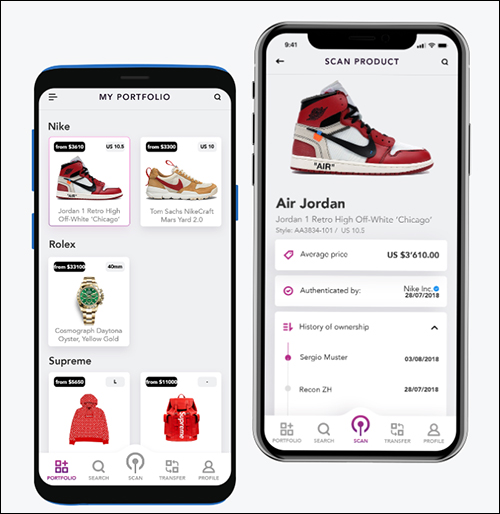Switzerland-based collectID has released a Near Field Communication (NFC) RFID solution enabling collectors to authenticate their products, resell items and better manage collectibles with the tap of a smartphone. The solution employs Identiv‘s tags for luxury apparel and warranty cards, as well as tamper-evident stickers for high-value shoes, bags, art, bicycles and wine bottles. The company hopes the technology and app will thwart counterfeiting, protect consumer confidence and create a new secure resale market, says David Geisser, collectID’s founder and CEO. The tags come with built-in NXP NTAG 424 DNA chips.
Shoe brand Sonra and Swiss football club FC St. Gallen are early adopters of the technology. Sonra is embedding the NFC tags into its shoes as they are produced, while FC St. Gallen is including the tags in its jerseys sold to fans. CollectID provides solutions for brands and resellers to equip their products with NFC tags at the factory, at the point of sale (POS) or at dedicated authentication stations. However, collectors can also purchase the tags directly to add to their existing products. The tags can be applied to bags, art, bikes and wine bottles, as well as to high-value clothing and warranty cards.

Traditionally, the authentication of high-value products has proven challenging, especially as a growing number of products are being sold online, and as buyers are paying for products before they are able to physically examine them. Geisser says CollectID has addressed this problem by combining blockchain and NFC technologies to offer a complete product-authentication ecosystem.
The 13.56 MHz NFC chip (which is compliant with the ISO 14443 standard) and the app (iOS- or Android-based) are designed to uniquely identify an item, and to provide security that prevents the tag’s cloning or removal. When the chip is interrogated by an NFC-enabled phone, it responds with a unique, secure message that changes with each interaction. This makes it impossible to duplicate the chip, the company reports. Since the chip is tamper-proof, it would be destroyed if someone tried to remove it and place it on another product.
Users can check the authenticity of a product and register their ownership of that item via the collectID app, after which the goods will appear in their personal collections. Data related to each tag ID and the product to which it is attached is captured and stored in blockchains to ensure they are immutable. In that way, Geisser says, “The system makes theft prevention and insurance processing cost-efficient and easy.” According to Forbes, counterfeiting was the largest criminal enterprise in the world in 2018. In fact, counterfeit goods represent $1.7 trillion of annual worldwide sales each year. According to Nextgov, there was a 38 percent increase in counterfeit goods seized by U.S. government agencies between 2012 and 2016.
CollectID’s solution leverages blockchain and NFC technologies. Users must download the collectID app, after which they can then tap their NFC-enabled smartphone near a product’s label. The app will display that item on the phone’s screen and confirm that it is authentic. App users who are collectors can create a digital closet in which they can keep all of their items’ information. That data is stored in the user’s personal digital account, while they can also create a token or digital twin of the product on the blockchain.
This twin is stored at multiple decentralized points, the company explains, and it would not be possible for anyone to change the data. A user can build collections and make them available for sale or trades. When a user resells a product, he or she can share information about it from the blockchain with potential buyers. At the time of sale, that person would then use the app and the phone to transfer ownership to the buyer by tapping the collectID tag and entering the relevant information.
Brands that embed the collectID tag into their high-value products can use the technology to maintain a connection with their customers. For instance, once a collector buys a product—a pair of sneakers, for instance—a company can access the owner’s information and send messages to that individual, providing coupons or other product offerings. The sales data provides analytics for the brands to understand where customer engagement is taking place, as well as where resale markets are.
CollectID was launched in 2018, Geisser says, around the idea of using blockchain to bring authentication to limited-edition products, starting with sneakers and luxury watches. “We realized there’s a big problem in knowing if products are authentic or not,” he states. After testing some NFC tags attached to sneakers, the company began working with Identiv. The firm needed a highly secure tag, says Klaus Simonmeyer, Identiv’s business-development director. “They also needed a tag that could withstand washing cycles and include a tamperproof feature,” he says. “No matter how you try to remove it, [that] will destroy the tag.”

collectID’s David Geisser
To identify the market for the solution, Geisser says, “We extensively spoke with different types of collectors,” who indicated that regardless of whether a product is artwork, a watch or a pair of shoes, the primary goal is to know that it is an original. “That’s really important,” he states, adding that it is especially challenging as more purchases are being made online. Some buyers use a third party to authenticate products, but that might not be necessary with the NFC tag.
Sonra and FC St. Gallen each plan to release tagged products this month, the company reports, while several other businesses are piloting the system as well. The tag can be added after production, Geisser says. In the case of personalized football jerseys and other clothing, the tag can be printed with the shirt’s badge during the printing process, known as flocking. A printer presses numbers or names onto each shirt, and the tag is placed on the underside of that number and thereby flocked directly onto the jersey.
Sonra, a German sustainable sneaker company, is embedding the tag into the tongue of the shoe, where the tag experiences the least friction and could be easily accessed via a smartphone. Tags built into products can be used to collect and access maintenance and servicing records, as long as the brands offer them. In that way, a product owner or a buyer can view a history of maintenance, as well as receive alerts when maintenance is due, or indicating what services were provided. For brands, the app enables them to turn a product into a sales channel for the next product. Users can opt out of receiving such data, Geisser notes, though most collectors to date have preferred to receive the content.
In addition, tags can be sent to users for attachment to products (typically inside the left shoe), after which the users can input data about those goods. These “unsecured” tags, however, will not prove authenticity. Identiv helped to develop the tags for a wide variety of products, Simonmeyer reports, including bikes. For collectors who want to apply the tags to their own products, the company offers the app with packets of five stickers. With regard to sneakers, the app is already populated with all high-end sneaker brands, the company claims, so users can simply read a shoe’s tag and select the correct brand to link that information with the unique ID number. According to the company, more than 5,000 collectors are already using the system to manage sneakers.
The anti-cloning feature of the NTAG 424 DNA and 424 DNA TagTamper chips leverages AES-128 encryption, Simonmeyer notes. This prevents a chip’s ID number from being captured and cloned, since the ID changes with each interrogation. CollectID chose Identiv’s sewn-in NTAG 424 DNA tags for clothes and shoes, as well as warranty cards, while NTAG 424 DNA TagTamper stickers and loops can be used on shoes and bags. Rigid, tamper-proof sticker tags are offered for art, bikes and wine bottles, while PVC cards with NTAG424 DNA tags are available for warranty cards.


